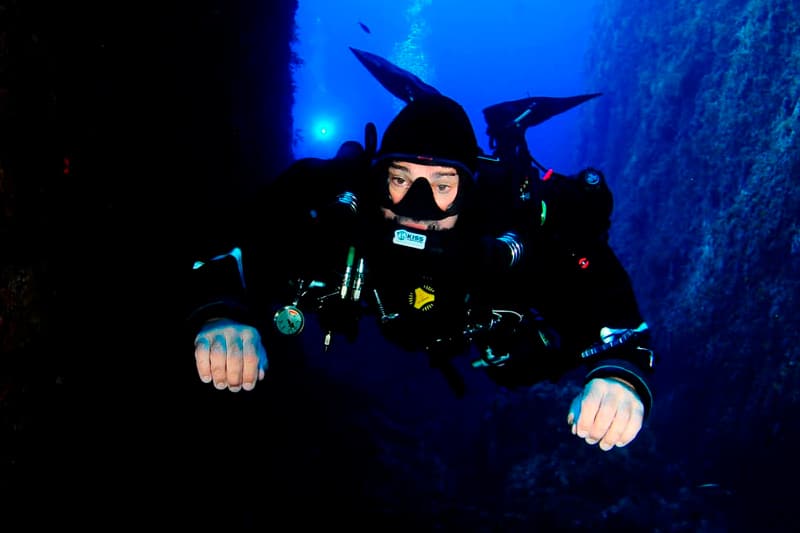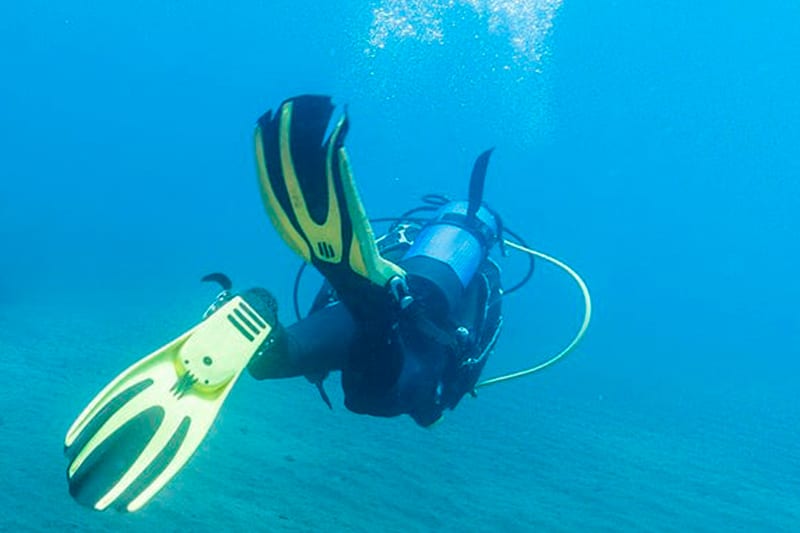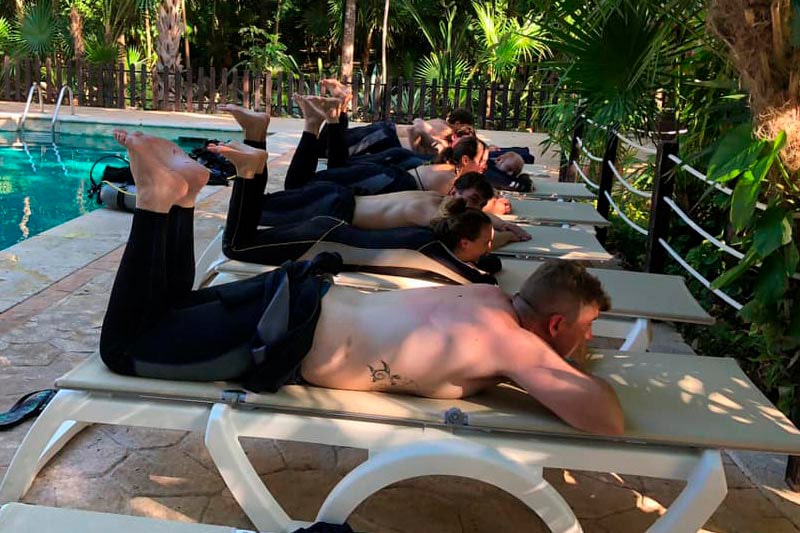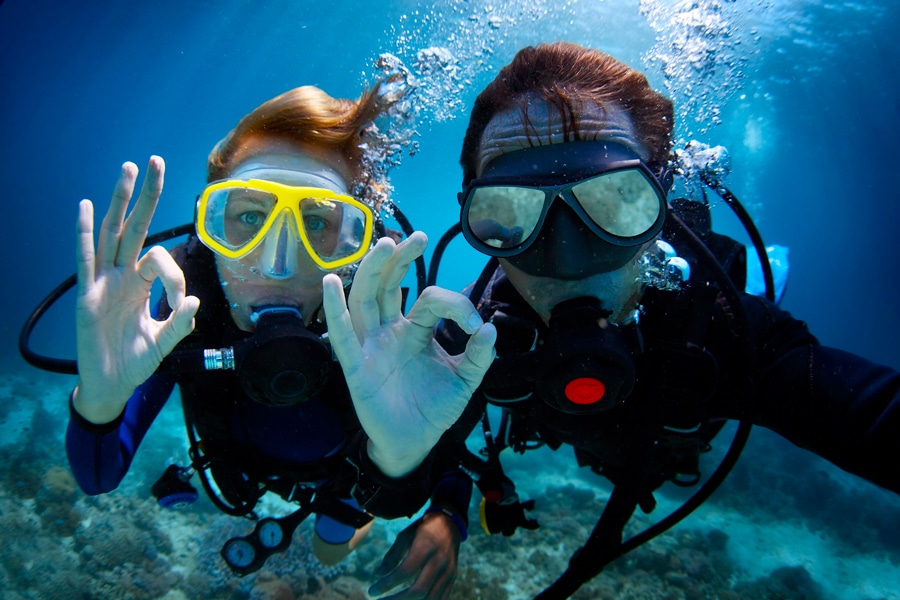Did you know that the scuba Frog Kick is the technical divers’ favorite one? It does not mean they have forgotten the other scuba diving kick techniques. They use this one for specific moments. In this article, we tell you when to use one or the others and teach you how to perform the scuba frog kick properly.

Welcome Back to Dressel Divers and the Go Green Spirit
20/07/2020
Scuba Safety Stop – What Is It And How To Do It?
27/08/20201. Frog Kick: From Swimming to Scuba Diving
2. How to Properly Perform Scuba Diving Frog Kick?
3. When to Use Scuba Frog Kick
4. Other Scuba Diving Kick Techniques

1. Frog Kick: From Swimming to Scuba Diving
There are few things more annoying than doing a group dive and not being able to see anything because your buddies lift all the sediment off the bottom with their flapping. Thankfully. There is a way to avoid this inconvenience, using the scuba diving frog kick.
When divers enter a cave, they often face the problem of sediment. When they use the alternative kick, these deposits, which are on the floor, rise, muddying the water. Lack of visibility can be a big problem in a cave, especially when diving through very narrow spaces. For this reason, cave divers looked for a new scuba dive kick technique until they reformulated an old swimming finning technique: the frog kick.
2. How to Properly Perform Scuba Diving Frog Kick?
The scuba Frog Kick follows a similar technique to the breaststroke swimming style, with a key difference. When diving, it begins with the feet raised above body height. The Diving Frog Kick consists of three movements.
Starting with the body in neutral buoyancy, the body and thighs should be horizontal, the calves perpendicular to the body at a 90° angle, and the fins parallel to the floor.
- The first movement of the scuba frog kick involves bringing the heels together while keeping the knees bent.
- The second movement is the actual kick, which consists of a strong contraction of the muscles (buttocks and femoral biceps). This action brings the fins back. Then, the diver’s ankles rotate downward, the flippers drop to the height of the rest of the body, and the knees extend just a little. In this type of kick, only the sole of the fins pushes the water. In contrast, using an alternative kick, the entire leg moves the water.
- The third movement involves returning to the initial position.
Divers often use a modified diving frog kick. The fundamental difference is that the impulse arc is smaller, resulting in the diver advancing more slowly

3. When to Use Scuba Frog Kick
By now, you may have guessed that the best time to use the Diving Frog Kick is during dives with slimy bottoms, such as wrecks and caves. In addition to these types of diving, there are also coral reef dives. Remember that touching the reef with an alternate kick can cause irreparable damage to the fragile fragments. Therefore, we could say that the scuba diving frog kick is more eco-friendly.
On the other hand, the diving frog kick is more energy-efficient than the flutter kick. When using this kick, divers need less muscular effort to propel themselves. However, it offers less propulsion. As mentioned in the article ‘10 Scuba Tech Tips to Improve Your Diving Air Consumption,’ reducing energy expenditure is crucial for saving air. This is another reason to explain why the scuba diving frog kick is so popular.
When there is a need to advance faster, for example, when overcoming a current, we advise using the alternate kick.

4. Other Scuba Diving Kick Techniques
In addition to the frog kick, divers often learn and practice various techniques to adapt to different underwater conditions.
Flutter Kick: This is a simple and effective kick used by both beginners and pros. The diver extends his legs and moves them up and down in an alternating motion. Keep your legs straight and your hips active to achieve maximum propulsive power!
Modified Flutter Kick: Ideal for confined spaces, this kick is very similar to the flutter kick but involves a hip twist. The legs move up and down, but the knees remain bent, and the kick is shorter. Executing it well requires precise buoyancy control, making it a technique mastered only by advanced divers.
Scissor Kick: Combining elements of the frog kick and standard kick for powerful propulsion. In this technique, the legs open and close simultaneously, resembling the motion of scissors cutting through the water from left to right, rather than up and down. It is an efficient, powerful kick, useful for swift movement with minimal effort.
Backward Frog Kick: It can be complicated, yes, but very effective. Although not for what people think. You will often hear some distracted diver say, ‘This scuba diving kick allows you to move backward without having to turn around.’ FALSE. Let’s think about it for a moment. In what environment would you need to move backward but not be able to turn around? Exactly! The answer is a cave or a wreck. Well, if you use the backward frog kick in those places, you’ll stir up the mud and dirt around in such a way that you won’t be able to see anything.
The truth is that this scuba diving kick is only useful for advanced level diving instructors, as they can maintain their position in front of the students.
Helicopter Turn Kick: This scuba diving kick offers divers the ability to spin their bodies around an axis without any forward or backward movement or reliance on their hands. A dive kick that has proved to be an excellent finning technique in environments like caves or wrecks where divers may need to change direction without disturbing sediment or impacting the seabed.
For a helicopter turn, start by keeping your knees slightly bent and your feet apart. Next, twist your feet in opposite directions—front and back—while simultaneously rotating your ankles. Mastering this intricate maneuver takes considerable practice, but it can be valuable if you’re contemplating exploring the realm of technical diving.
All these diving kicks are useful, there is none better than the rest. Every good diver should be able to alternate these and other kicks to optimize their performance. Do you have any questions about the scuba frog kick or any other diving Kick? Contact us.



